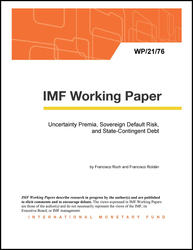
Uncertainty Premia, Sovereign Default Risk, and State-Contingent Debt
Uncertainty Premia, Sovereign Default Risk, and State-Contingent Debt
READ MORE...
Volume/Issue:
Volume 2021
Issue 076
Publication date: March 2021
ISBN: 9781513572635
$18.00
Add to Cart by clicking price of the language and format you'd like to purchase
Available Languages and Formats
| English |
Prices in red indicate formats that are not yet available but are forthcoming.
Topics covered in this book
This title contains information about the following subjects.
Click on a subject if you would like to see other titles with the same subjects.
Exports and Imports , Economics- Macroeconomics , Public Finance , Economics / General , International - Economics , Sovereign debt , default , state-contingent debt instruments , robust control , ambiguity premia , probability distortion , robust lender , State-contingent debt , ambiguity aversion , debt structure , threshold bond , Bonds , Debt default , Rational expectations , Asset prices
Also of interest
Summary
We analyze how concerns for model misspecification on the part of international lenders affect the desirability of issuing state-contingent debt instruments in a standard sovereign default model à la Eaton and Gersovitz (1981). We show that for the commonly used threshold state-contingent bond structure (e.g., the GDP-linked bond issued by Argentina in 2005), the model with robustness generates ambiguity premia in bond spreads that can explain most of what the literature has labeled as novelty premium. While the government would be better off with this bond when facing rational expectations lenders, this additional source of premia leads to welfare losses when facing robust lenders. Finally, we characterize the optimal design of the state-contingent bond and show how it varies with the level of robustness. Our findings rationalize the little use of these instruments in practice and shed light on their optimal design.
Copyright © 2010 - 2025
Powered by:
AIDC



